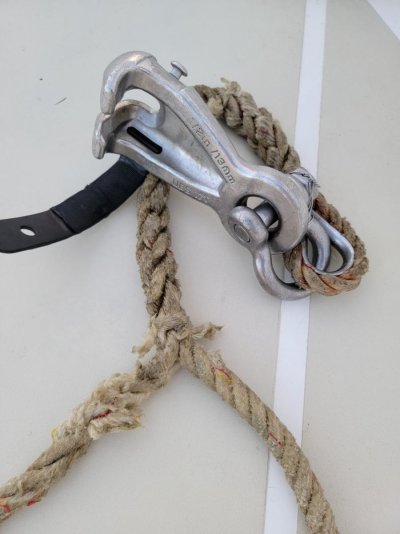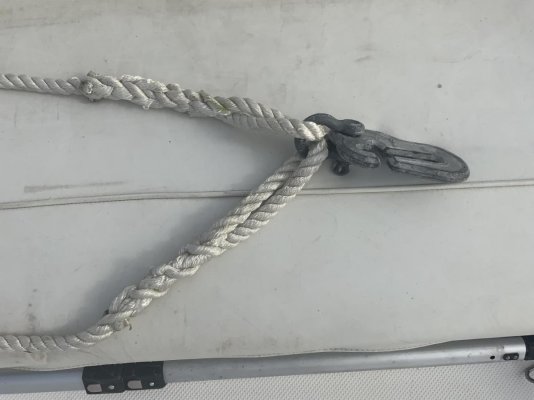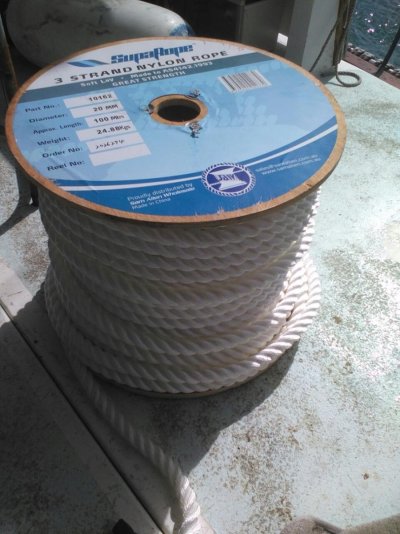I got carried away or obsessed and fretted about our dinghy setup for quite a while. I had to laugh when I saw your initial photo because that could have been taken on our boat at one point, with the same result. Tried large, really expensive black rubber snubbers and two lines separately back-braided through the snubber eye but the snubbers left black marks on the white swim step. I've had lots of practice braiding three-strand over the years and I can do some pretty creative things, but often with the same result as your photo and I got annoyed. After years of trying different things, we settled on the following. Our boats and the configurations are certainly different so yours will vary of course, but this is what we finally do:
For mooring the dingy to the boat, I use two lines. Big bronze snap-clips (Defender, they're not cheap but last forever), clipped to the metal mooring rings or the vinyl hand-holds at each end of the dinghy. I braid the three-strand to the snap clips myself, minor task as firehoser mentions above. Then, after years of experimentation and lots of far more expensive options that didn't work for one reason or another, I snake the mooring lines through the center of oversize pool noodles, matching the green "theme color" of the boat and boat canvas. Standard pool noodles are about 2.5" in diameter, I'm talking "jumbo," which are 3.5 or even larger by special order. They only last one season so I have to replace them every year, but they only cost a few dollars and work so well who cares. They usually come 55" long, but that's too long. I whack them to 48" or just a little less. I figured the further from the boat the better, but that's wrong, too long doesn't work well, they flex too much and let the dinghy bounce off the boat with every wave. Then I back braid snap clips to the other end of the mooring lines. If you get the right size snap clips and the jumbo noodles, you can use string to yank the snap clips through the center holes of the pool noodles. I leave about one foot of line and clips hanging out each end of the noodles. The great thing is that unlike real marine snubbers, when you want to pull the dinghy in close, you can easily bend the noodles, but otherwise they're surprisingly good at holding the dingy off in chop or wind.
And then when we're running, we have a separate system as a towing bridle, but same general idea. One line goes from the metal D-rings on each side of the dingy's bow, again with snap clips braided to the ends. Then I use a second towing line for the tail of the "Y" with a welded metal rigging ring braided on one end, then a peanut buoy (you know, those bean-shaped floats they use to mark swimming pool lap lanes). Rigging rings are common in hardware stores, it's just a welded metal ring, and we let that ring free-ride back and forth on the line that runs between the dinghy d-rings. In other words the whole thing makes a "Y" with a long tail to the center swim-step cleat. I also make sure the ring diameter is just a little smaller than the bronze snap clips at the dinghy, because then even if a D-ring or D-ring mount fails on the dinghy, the line will run out until the snap clip hits the ring and the worst thing that happens is the dinghy gets towed on a slant by the remaining d-ring until somebody notices (or until the other one rips off too). You can get carried away with this whole thing and buy mountain-climber stuff, but back braiding is easy and you can make your own once you get the hang of it. But here's an example if you want to spend the money:
https://www.ebay.com/itm/264291429990
Wish I had a picture of the whole thing but the boat is 90 minutes away. The great things about our setup is (1) any separate part or piece can be easily re-made or replaced if it chafes or wears out at very low cost, and (2) the mooring noodles float and are easy to grab, so I don't have to use polypropylene rope which I generally don't like and it's really stiff for braiding, and (3) using peanut buoys on the towing line also keeps the line at or near the surface so it doesn't foul the prop, and the peanut buoys are aerodynamic (hydrodynamic?) so they don't introduce much drag.
Yes, you can see I've over-thought all this really badly.



